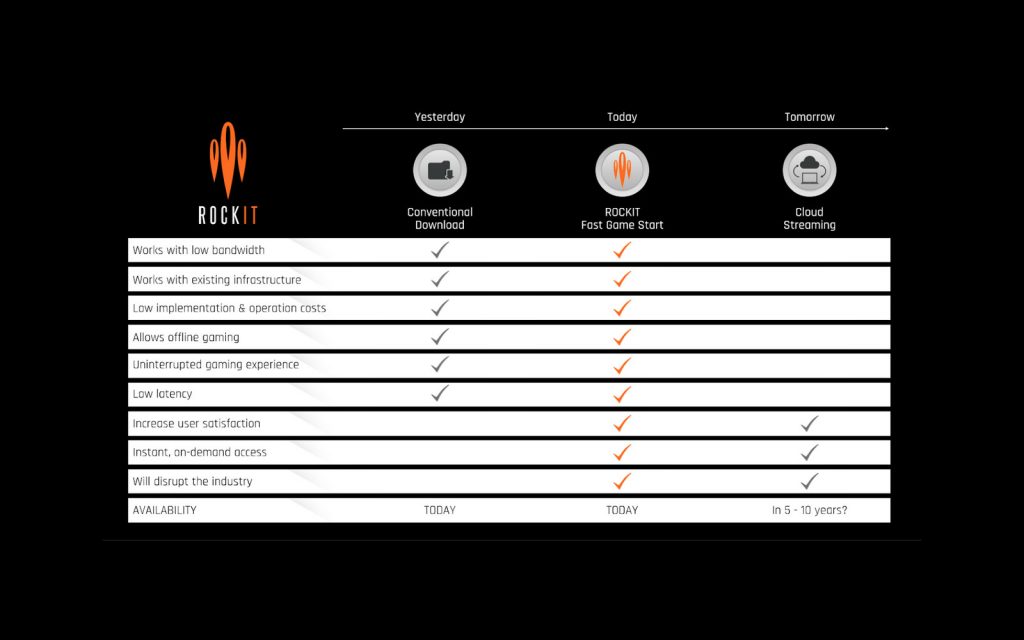The Cost of Cloud Gaming: Services May Need to Charge $30 per Month Just to Break Even

ROCKIT Fast Game Start Provides All The Perks of Cloud Streaming Without Burdensome Infrastructure & Economics
Fast Game Start provides many of the experiential benefits generally associated with cloud streaming. ROCKIT Fast Game Start is ready now, on today’s infrastructure, with almost zero impact to the cost of delivering games.
In our prior blog we wrote about the many opportunities created by offering users Click to Play experiences that can power subscriptions, rentals and instant-play demos. But how does ROCKIT compare to cloud streaming?
In the cloud streaming model, games are hosted on cloud servers with similar hardware to gaming PCs. This hardware is allocated to users every time they play. With Fast Game Start, users host their own games on their own hardware, but have quick access without long download times. Implemented effectively, the experience for users is similar – they are able to browse and play games with little switching time. But the back end, the infrastructure, has major differences impacting all aspects of technology and game business economics.
Fast Game Start does not require building a new infrastructure for instant access to games. Using industry standard servers and protocols much as they are today, combined with cloud based machine learning ROCKIT enables unlimited scalability at minimum cost.
Cloud Streaming requires games to run in the cloud with all of the hardware necessary for gameplay except the screen and I/O devices. Those servers must include gaming-grade graphics cards, memory, CPU’s and more. Instead of a display, they render graphics to an internal frame buffer which is then encoded like a video for transmission to a remote client.
“The main challenge I believe has been service infrastructure, the bandwidth you need to deliver that opportunity on scale” Matt Bilbey, Executive VP of strategic growth, Electronic Arts (EA).
The infrastructure technical requirements and the cost to provide these services are frequently sighted as major obstacles. But how complex, and how expensive will it be to operate these services? And what price can consumers expect to pay?
The cost of operating gaming PCs in the cloud is a function of the hardware cost, power, and server density. We estimate that future game servers will be able to accommodate 4 simultaneous users, with a capital cost of about $7,000 and a data center cost of about $300 per concurrent user per year, bringing the annual cost per concurrent user to over $1,000. The network bandwidth requirement for a single concurrent user, streaming at 4mbps of encoded video, would total 15,768 Gigabytes per year and would cost $157 annually. For a game that is pay to play, presumably you would monetize those costs. But for free to play, where perhaps 19 out of 20 users don’t pay anything, the cost of running servers would be $23,140 per year per concurrent paying user – and of that, $21,980 would be for the players who aren’t monetized!
“Storing and running a game in the cloud may be insanely cheap, but beaming that game over the network to players may be very expensive to one party or the other,” Rob Fahey, gamesindustry.biz.
If we assume that each concurrent user maps to about 20 real world users, and if we assume that about $140 per user would be required for content licensing for premium games, then a premium cloud gaming service would need to charge about $360, including marketing and business expenses. That’s $60 for operation, $140 for content, and $160 for marketing & business expenses. So a cloud gaming service would need to charge about $30 per month – just to break even.
The challenge continues as these servers must sit at the emerging cloud-edge, in local data centers close to users to minimize latency. This opportunity to run data centers 24/7 serving Cleveland by day and Shanghai by night does not work in the edge paradigm – peak capacity needs to be locally accommodated, and game-centric servers may sit idle as consumer sleep.